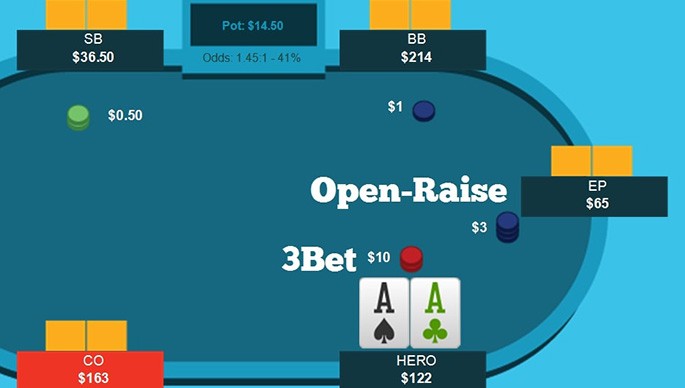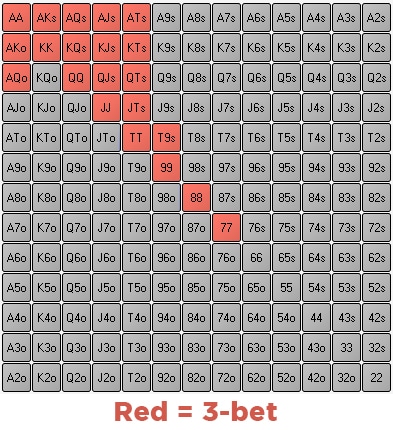
The world of poker—a realm where psychology and strategy mesh in a complex dance of wits. Today, we delve into a critical concept in the art of poker strategy: the 3-bet. If you’ve ever been puzzled by terms like “what is a 3-bet in poker” or “3-bet poker meaning,” this comprehensive guide is for you. We’ll explore 3-betting in poker, its tactical applications, the range implications, and even peek into the advanced realm of 3-bet range charts. Buckle up!
The ABCs of a 3-Bet: Definitions and Basics
Firstly, let’s settle what a 3-bet really is. Contrary to its enigmatic aura, the 3-bet is a third bet in a series of bets during a single round of poker. Simply put, after the first opening bet and the subsequent call or raise, the next raise is what’s commonly known as a 3-bet. It’s an aggressive move designed to steal the pot or inflate it for higher gains. Often misunderstood, the term is part of the essential lexicon for anyone keen on mastering poker strategy.
Best casino slots in 2022 USA

300% Welcome Bonus |

Choose 100% Bonus |

Take 100% Welcome Bonus |

100% free spins |
Have you ever wondered what does 3 bet mean in poker during a late-night card game? A well-timed 3-bet can serve as an excellent tool to dissect your opponents’ strategies. It can be a bluff, aiming to provoke a fold, or a value bet, seeking to trap an opponent in a money-losing situation. While “3-betting” may sound complicated, it has specific use-cases that can fit into almost any player’s strategy, regardless of skill level.
When it comes to three-bet poker, understanding the basics is just the starting point. We can’t overlook the variety of situations that dictate when a 3-bet is appropriate or not. For example, a 3-bet against a skilled player who has a tight range might be a risky proposition. Conversely, 3-betting a more liberal player can lead to a lucrative payoff. The key is to identify your opponent’s 3-bet range chart and act accordingly.
What’s a 3-bet in poker, you ask? Well, by now, you should have a foundational understanding. But let’s keep digging to reveal the nuanced layers that make the 3-bet a game-changer in poker.

Beyond the Basics: How to Use a 3-Bet Effectively
So, you’ve got the fundamentals down, but how do you transform this knowledge into an effective strategy? The answer lies in two words: 3-bet ranges. These are predetermined groups of hands that you are willing to 3-bet with. While a 3-bet range chart may look like an intricate roadmap of strategic choices, it’s essentially a guide that helps you decide when and with what hands to make a 3-bet. Depending on your position at the table and your read on your opponents, your range can be tight or wide, thus dictating your 3-betting range.
In the realm of poker 3-betting, it’s important to consider the concept of 3-bet calling range. This refers to the range of hands with which you would call an opponent’s 3-bet. Your 3-bet calling range should generally be narrower than your 3-bet range, as the latter includes both value hands and bluffs, while the former should primarily consist of hands that you believe have a good chance to win if it goes to a showdown.
Another layer of complexity is added when considering your opponents’ potential responses to your 3-bets. This is where the psychology of what is 3 betting in poker comes into play. Are they likely to 4-bet you, call, or fold? Understanding these potential outcomes will help you choose the most effective 3-betting strategy for each situation. For example, a tighter opponent might fold more frequently, making a bluff 3-bet more effective.
While what is a 3-bet in Texas Hold’em remains consistent, the situational factors can differ vastly. You may be more inclined to 3-bet when you’re in a late position as compared to being in the small blind or big blind. This is because your position gives you more information about the actions that players took before you and helps you make more accurate estimations of their ranges.
Understanding the Math: Odds, Probabilities, and Expected Value
What about the mathematics behind a 3-bet? Yes, poker isn’t just a game of guts and glory; numbers have their day too. The term you’ll hear frequently in this context is Expected Value (EV). EV calculates the potential return on your bets, allowing you to gauge whether a 3-bet is profitable in the long run.
Similarly, understanding pot odds is crucial for determining when to 3-bet. Pot odds compare the current size of the pot to the cost of a contemplated call. If you’re considering a 3-bet bluff, you would ideally want to have better pot odds than your chances of making a winning hand by the river.
Calculating implied odds adds another layer to this mathematical cake. This refers to the money that you can expect to win from your opponent in future betting rounds, beyond what is already in the pot. This is particularly relevant when you have a drawing hand that may not be the best at the moment, but has a high potential for improvement. In such cases, 3-betting can be an extremely effective tactic.
In essence, integrating math into your three betting strategy will allow you to make more informed decisions, rather than relying solely on gut feeling or intuition. This balanced approach is the key to a well-rounded and more profitable poker game.

Advanced Tactics: Metagame and Player Profiling
Even if you know what a 3bet in poker, the metagame is where things get truly fascinating. This is the game beyond the game, involving strategies that incorporate psychological aspects and long-term planning. For example, using a 3-bet effectively against a player you often find yourself pitted against can set the stage for future hands, potentially throwing them off their game.
Player profiling is a robust tool for any poker player, especially when it comes to 3-betting. Is your opponent a ‘calling station’ who rarely folds? A 3-bet bluff might not be as effective. Alternatively, an aggressive player might see your 3-bet range chart as a challenge and try to 4-bet you. Understanding these traits allows you to tailor your 3-betting strategy on a player-by-player basis, adding yet another level of complexity to the game.
What is a three-bet without its psychological implications? Manipulating your image at the table can greatly influence the effectiveness of your 3-bets. You can purposely establish a tight image to encourage more folds when you eventually loosen up with your 3-betting range. Conversely, maintaining an aggressive image might make opponents second-guess calling your 3-bets, assuming you’re always betting for value.
Tailoring your 3-bet ranges and 3-betting frequency based on player profiling can be a dynamic way to maintain an edge in poker. After all, no strategy remains effective if it becomes predictable. Keep your opponents guessing, and the pots will likely find their way to you more often than not.
Conclusion
From the uninformed spectator’s perspective, a 3-bet might seem like just another bet on the table. But as we’ve uncovered, it’s a multifaceted strategy layered with tactical depth, psychological nuance, and mathematical complexity. Understanding what is a 3-bet in poker can set you on a path to becoming a more calculated, more successful player. So the next time you find yourself in a position to make a 3-bet, remember: it’s not just a bet, it’s a statement. It shows your understanding of the game, how you understand your opponents, and most importantly, it shows your poker acumen.
Best casino slots in 2022 USA


300% Welcome Bonus |

Choose 100% Bonus |

Take 100% Welcome Bonus |

100% free spins |
